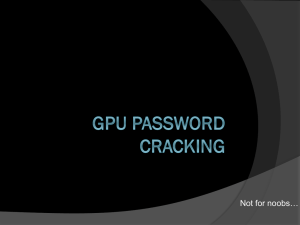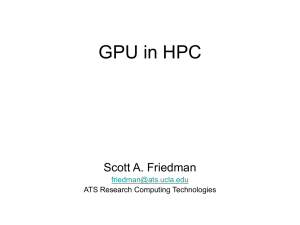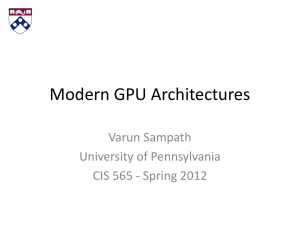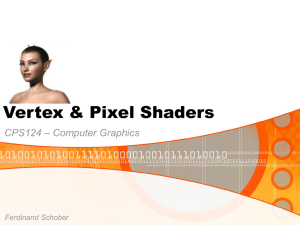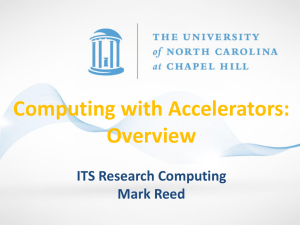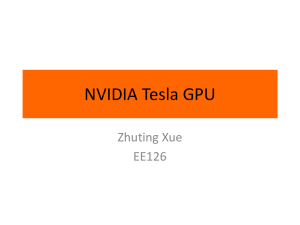Mobile GPUs - CIS 565: GPU Programming and Architecture
advertisement
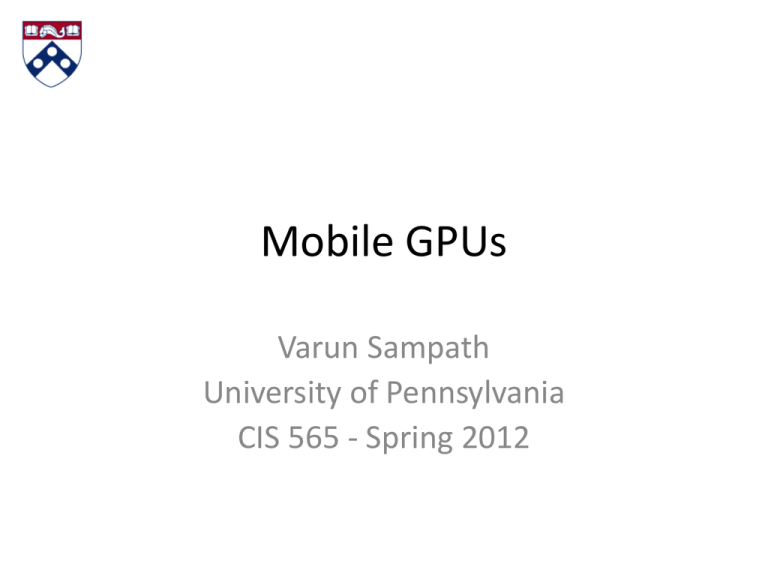
Mobile GPUs Varun Sampath University of Pennsylvania CIS 565 - Spring 2012 Agenda • SoCs • Case Studies – NVIDIA Tegra 2, Tegra 3 – Imagination Technologies’ PowerVR SGX Series5XT – Apple iPad (2012) • Future • Note about sources What is an SoC? • System-on-a-Chip Mobile SoC Market Share 2011 – CPU, GPU, DSP, I/O – Single-chip solution • Top mobile SoC vendors: – Qualcomm, Apple, TI, Samsung, NVIDIA • Advantages of using SoCs? • Disadvantages? • We will see all consumer chips converge to SoCs Others 12% Apple 23% TI 17% Samsung 14% NVIDIA 3% Qualcomm 31% Market Share Data from PC Perspective What is an SoC? Image from iFixit Block Diagram of TI OMAP 4470 Image from TI Brief Discussion of ARM • RISC CPU vendor that currently dominates mobile • Mobile Designs: Cortex-A8, A9, A15 • Fabless Designer – Core Design Licensees – Architecture Licensees • Qualcomm Scorpion/Krait • NVIDIA The Constraints of Mobile • Energy – Cell phone battery capacity of 5-7 Wh (tablets 2040 Wh) – How much energy can our chips consume? • Area – PCB size constraints – Cooling constraints Some Energy Numbers Data from AnandTech Some Contributors to Switching Energy • Off-chip Interconnect (to DRAM) – Bandwidth is expensive – Minimize reasons to fire up memory bus • High frequencies – Requires increased voltages Some Theoretical Performance Numbers Apple iPad 2 ASUS Transformer Prime Some Nice Desktop CPU A5 @ 1GHz Tegra 3 @ 1.4GHz Sandy Bridge @ 3.4GHz GPU POWERVR SGX543MP2 @ 250MHz Mobile GeForce @ GTX680 @ 1GHz 500MHz Memory Interface 64-bit @ (maybe) 800MHz = 6.4GB/s 32-bit 256-bit @ 6GHz = 192GB/s GPU GFLOPS 16 GFLOPS 12 GFLOPS 3 TFLOPS Mobile Data from AnandTech GTX680 Specs from Newegg GeForce GPU in NVIDIA Tegra 2 Image from NVIDIA Tegra 2 Mobile GeForce • Separate vertex and pixel shaders – 4 of each, each capable of 1 multiply-add /clock • Pixel, texture, vertex, and attribute caches – Reduce memory transactions – Pixel cache useful for UI components • Memory controller optimizations – Arbitrate between CPU & GPU requests – Reorder requests to limit bank switching NVIDIA Tegra 3 (Kal-El) • Expanded Mobile GeForce – 4 vertex and 8 pixel shaders • 4-PLUS-1 architecture Image from AnandTech PowerVR SGX • TA (Tile Accelerator) – store scene data and split up screen into tiles • ISP (Image Synthesis Processor) – perform Hidden Surface Removal with ztesting • TSP (Texture and Shading Processor) – run pixel shader Image from ImgTec PowerVR SGX Series5XT Summarizing PowerVR SGX Series5XT • Used in Apple A5, A5X • Unified shader architecture (called USSE2) • Tile based deferred rendering (TBDR) – Will cover in more detail next week • Multi-core architecture Mobile GPU Families • Qualcomm Adreno – Unified shaders, 4-wide SIMD – immediate mode with early-z • Imagination Technologies’ PowerVR SGX Series5XT – Unified shaders, 4-wide SIMD – Tile based deferred rendering • NVIDIA Mobile GeForce – Separate vertex (4) & pixel (8/12) shaders , scalar – immediate mode with early-z • ARM Mali – Separate vertex (1) & pixel (4) shaders , 4/2-wide SIMD – immediate mode with early-z Analysis by AnandTech Demands for Mobile • Higher screen resolutions – Requires more memory bandwidth – Pixel count growing higher than geometry? • Longer battery life • Higher quality mobile gaming Case Study: the new iPad • Screen resolution of 2048x1536 – Quadruple the pixels of previous 1024x768 version – Higher than nearly all desktop and laptop displays • Battery life approximately equal to previous version • Gaming performance? iPad Gaming Performance Image from AnandTech Apple A5X Die Shot Image from UBMTechInsights Apple iPad Statistics Apple iPad 2 Apple iPad (2012) 11” Apple MBA CPU A5 @ 1GHz A5X @ 1GHz Sandy Bridge @ 1.8GHz GPU POWERVR SGX543MP2 @ 250MHz POWERVR SGX543MP4 @ 250MHz Sandy Bridge IGP @ 350MHz/1.2GHz Memory Interface 64-bit @ 800MHz = 6.4GB/s 128-bit (for GPU) 128-bit @ 1.3GHz = 20.8GB/s Die Size 122mm2 163mm2 149mm2 Battery Size 25Wh 42.5Wh 35Wh Data and Image from AnandTech What will the future bring? • GPU Compute – PowerVR SGX Series5XT OpenCL capable, but no drivers – Could do compute the old-fashioned way with GLSL – Direct3D 11 means Compute Shader support • PowerVR Series6 press release suggests 100-1000 GFLOPS • Kepler-based GPU coming to a super phone near you?

